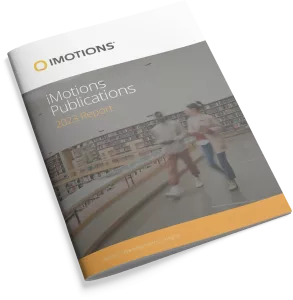-
Self-control: Knowledge or perishable resource?
Abstract: The self-control literature suggests two main short-run models with contradictory predictions. By perceiving self-control as a knowledge or perishable resource, those models report a positive and negative impact, respectively, of an initial self-control act on subsequent self-control ability. Using biometric data to monitor compliance enabled us to develop a unified self-control model, reconciling the […] -
Sensing and Learning Human Annotators Engaged in Narrative Sensemaking
Abstract: While labor issues and quality assurance in crowdwork are increasingly studied, how annotators make sense of texts and how they are personally impacted by doing so are not. We study these questions via a narrative-sorting annotation task, where carefully selected (by sequentiality, topic, emotional content, and length) collections of tweets serve as examples of […] -
Unsold is unseen … or is it? Examining the role of peripheral vision in the consumer choice process using eye-tracking methodology
In visual marketing, the truism that “unseen is unsold” means that products that are not noticed will not be sold. This truism rests on the idea that the consumer choice process is heavily influenced by visual search. However, given that the majority of available products are not seen by consumers, this article examines the role […] -
Consumer Evaluation of Hotel Service Robots
Abstract: In light of the trend in integrating artificial intelligence and robotics into tourism and hospitality operations, it is important to understand consumer responses to hotel service robots. Two studies were conducted to achieve this objective: an online survey and a laboratory experiment using measurements of automatic emotional reactions via biosensors. Responses to two types […] -
Identifying correlation between facial expression and heart rate and skin conductance with iMotions biometric platform
Abstract: Emotional reactions are stimulated when humans are presented with a stimulus, triggering a series of voluntary and involuntary responses. Human emotions can be measured from facial expressions and physiological processes. The iMotions biometric platform can detect and analyze the responses of different individuals, which are personalized. The iMotions software allows for the quantification of seven […] -
Reducing Brain Signal Noise in the Prediction of Economic Choices: A Case Study in Neuroeconomics
Abstract: In order to reduce the noise of brain signals, neuroeconomic experiments typically aggregate data from hundreds of trials collected from a few individuals. This contrasts with the principle of simple and controlled designs in experimental and behavioral economics. We use a frequency domain variant of the stationary subspace analysis (SSA) technique, denoted as DSSA, […] -
Enhancing Exercise Experience with Individual Multi-Emotion Provoking Game Elements
Abstract: In this work we present a new affective game design method that includes multi-emotion provoking and continuous game elements. Evaluated with our physical cycling exergaming system it extends our previously designed single emotion game scene approach. In addition we introduce new entertaining content that includes game elements to provoke both physical and mental stress as […] -
Emotional Journey for an Emotion Provoking Cycling Exergame
Abstract: In this work we present a novel concept for affective entertainment, which we call Emotional Journey. It provides a dynamic and adaptive story path based on a player’s emotional responses and yields improved accurate recognition of the player’s emotions. We conducted a case study with 25 players to evaluate our concept using our cycling […] -
A Framework to Bridge Teachers, Student’s Affective State, and Improve Academic Performance
Abstract: Some of the biggest problems tackling Higher Education Institutions (HEI) are student’s drop-out and academic disengagement. Physical or psychological disabilities, social-economic or academic marginalization, and emotional and affective problems, are some of the factors that can lead to it. This problematic is worsened by the shortage of educational resources that can bridge the communication gap […] -
Toward Affect-Sensitive Virtual Human Tutors: The Influence of Facial Expressions on Learning and Emotion
Abstract: Affective support can play a central role in adaptive learning environments. Although virtual human tutors hold significant promise for providing affective support, a key open question is how a tutor’s facial expressions can influence learners’ performance. In this paper, we report on a study to examine the influence of a human tutor agent’s facial […]
Research Report 2024
In-depth look at the scientific landscape as powered by iMotions software, showcasing groundbreaking research and the impact of our tools in various scientific and industrial fields.

iMotions Science Resources
Looking for white papers, validation reports or research show casing iMotions Multimodal capabilities?
Share Your Research

850+ universities worldwide with an iMotions human behavior lab
73 of the top 100 highest ranked universities
710+ published research papers using iMotions
iMotions is used for some of the most interesting human behavior research studies carried out by top researchers around the world. Contact us to have your publication featured here.
The authors of these publications have used iMotions as a software tool within their research.
“Software should be cited on the same basis as any other research product such as a paper or a book; that is, authors should cite the appropriate set of software products just as they cite the appropriate set of papers” (Katz et al., 2020).
We therefore encourage you to cite the use of iMotions where appropriate.
How to cite iMotions
APA
iMotions (10), iMotions A/S, Copenhagen, Denmark, (2024).
Note: adjust the version and year where relevant.
5 Most Popular Blogs
Publications
Read publications made possible with iMotions
Blog
Get inspired and learn more from our expert content writers
Newsletter
A monthly close up of latest product and research news


